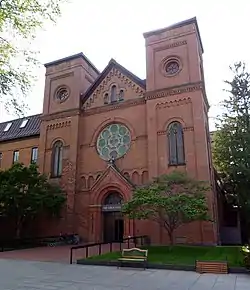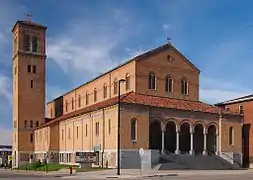 Saint John's Abbey Church and Bell Banner, on the Campus of Saint John's University | |
 Location within Minnesota  Saint John's Abbey, Collegeville (the United States) | |
| Monastery information | |
|---|---|
| Order | Order of Saint Benedict |
| Established | 1856 |
| Mother house | Saint Vincent Archabbey, Latrobe, Pennsylvania (founded 1846) |
| Archdiocese | Roman Catholic Archdiocese of Saint Paul and Minneapolis |
| Diocese | Roman Catholic Diocese of Saint Cloud |
| Controlled churches | 19 total Monastic Residence points outside of the Abbey, and 16 of them being Benedictine- run Parishes |
| People | |
| Founder(s) | Fr. Bruno Riss, O.S.B., Fr. Cornelius Wittmann, O.S.B., and the founding German Benedictines. |
| Abbot | Rt. Rev. Fr. Doug Mullin, O.S.B. |
| Prior | Rev. Fr. Eric Hollas, O.S.B. |
| Site | |
| Location | 2900 Abbey Plaza, Collegeville, Minnesota, United States |
| Coordinates | 45°34′49″N 94°23′32″W / 45.58028°N 94.39222°W |
| Public access | Yes |
| Website | www |
St. John's Abbey and University Historic District | |
 The Great Hall, which served as the abbey church until the construction of the current church | |
| Area | 26 acres (11 ha) |
| Built | 1868–1959 |
| Architect | Multiple |
| Architectural style | Late Victorian, Second Empire, Romanesque Revival |
| NRHP reference No. | 79001256[1] |
| Added to NRHP | March 23, 1979 |
Saint John's Abbey is a Benedictine monastery in Collegeville Township, Minnesota, United States, affiliated with the American-Cassinese Congregation. The abbey was established following the arrival in the area of monks from Saint Vincent Archabbey in Pennsylvania in 1856. Saint John's is one of the largest Benedictine abbeys in the Western Hemisphere, with 110 professed monks.[2] The Right Reverend Fr. Doug Mullin, OSB, serves as the eleventh abbot.
A school founded at the abbey grew into Saint John's University in 1883. 17 buildings constructed at the abbey and university between 1868 and 1959 are listed on the National Register of Historic Places as the St. John's Abbey and University Historic District.[3]
Establishment
In 1856, five monks of Saint Vincent Archabbey in Latrobe, Pennsylvania, arrived in St. Cloud, Minnesota.[4] They established a priory there and began to minister to the German immigrants in central Minnesota. One of the first ministries of the new community was Saint John's College, which would come to be known as Saint John's Preparatory School. In 1862 the community moved some miles west, into the wooded area of the valley, and again in 1865 to the shores of Lake Sagatagan. It was in this location that the community began to flourish, and in 1866 the priory was raised to the status of Abbey and the community elected Fr. Rupert Seidenbusch as the first Abbot.
Abbey Church of Saint John the Baptist
By the early 1950s the monastic community had reached to a near 450 monks, and had outgrown the original abbey church and so plans were made to construct a new, larger worship space which could accommodate a larger congregation.[5] The liturgical movement which would culminate in the Second Vatican Council was in full swing at Saint John's and so the new church was also to be designed with some of the anticipated liturgical changes in mind. (Following the Council, almost no changes needed to be made to incorporate the new liturgical rules.) The community contacted twelve architects and asked them to submit plans for a church which would "be truly an architectural monument to the service of God."[6] In 1954 the community selected Marcel Breuer to design not only the new church but an addition to the monastic enclosure.
Breuer's design incorporated the traditional axis of baptistery, nave, and altar in a modern concrete structure.[7] The monastic choir stalls and Abbot's throne were placed in a less traditional semi-circular shape around the main altar, which also served to invite the congregation closer.[6] The church was designed so that even with a capacity of over 2000, the entire community was able to feel like they were intimately involved in the liturgy. Perhaps the most striking part of the design was the facade and bell tower, which itself was shaped like a large bell and sat suspended over the main entrance of the church. The "banner" rises 112 vertical feet in front of the church and houses the 5 bells which sound the hours and call the monastic and university communities to prayer.[8][5] The north facade of the building is the largest wall of stained glass in the world and contains 430 colorful hexagons of abstract design.
Construction of the church began on May 19, 1958, and lasted until August 24, 1961.[5] The church was consecrated in the fall of 1961 and serves to this day as the principal liturgical space of both the monastic community and the university. The monastic community gathers for Morning Prayer, Midday Prayer, Mass, and Evening Prayer every weekday and except for rare occasions these liturgies are open to the public.[9] On the weekends there is not public Midday Prayer. All liturgical events in the Abbey Church are livestreamed on the Abbey website.
Grounds
In addition to the preparatory school, the abbey also established Saint John's University, which was connected to the abbey itself by "Quadrangle", at the time the largest building west of the Mississippi River dedicated to education. The abbey also operates the Liturgical Press, one of the foremost liturgical publishing houses in the United States.[10] Also located on the grounds of the abbey are the Collegeville Institute for Ecumenical and Cultural Research, the Episcopal House of Prayer (Diocese of Minnesota), the original Minnesota Public Radio studio, and the Saint John the Baptist Parish Center. The 2,500-acre (10 km2) grounds of the abbey comprise lakes, prairie, and hardwoods on rolling glacial moraine, and have been designated the Saint John's Arboretum. The abbey is the location of a number of structures designed by the modernist Bauhaus architect Marcel Breuer. The Abbey Church, with its banner bell tower, is one of his best-known works. The upper church houses the newly expanded Holtkamp Pasi organ with over 6,000 pipes. In its undercroft is a chapel that contains the relics of Saint Peregrine.
A historic district of 17 buildings at Saint John's Abbey and University was listed on the National Register of Historic Places in 1979 for having national significance in the themes of architecture, community planning and development, education, and religion.[11] It was nominated for being an architecturally and historically significant campus of a leading religious and educational institution of the Order of Saint Benedict.[3]
The abbey is the setting for The Cloister Walk, a collection of essays on Christian spirituality by Kathleen Norris.
The grounds include the Episcopal House of Prayer, a retreat center affiliated with the Episcopal Church.[12]
Ministries
Outside of Saint John's, the abbey's monks serve 12 parishes along with various nursing homes and hospitals in the Diocese of Saint Cloud.
The Saint John's Bible
The Saint John's Bible is the first completely handwritten and illuminated Bible to have been commissioned by a Benedictine monastery since the invention of the printing press.
List of Abbots
- Rt. Rev. Rupert Seidenbusch, O.S.B. (1866–1875) Named Bishop of the Vicariate Apostolic of Northern Minnesota
- Rt. Rev. Alexius Edelbrock, O.S.B. (1875–1889)
- Rt. Rev. Bernard Locnikar, O.S.B. (1890–1894)
- Rt. Rev. Peter Engel, O.S.B. (1894–1921)
- Rt. Rev. Alcuin Deutsch, O.S.B. (1921–1950)
- Rt. Rev. Baldwin Dworschak, O.S.B. (1950–1971)
- Rt. Rev. John Eidenschink, O.S.B. (1971–1979)
- Rt. Rev. Jerome Theisen, O.S.B. (1979–1992) Elected Abbot Primate of the Benedictine Confederation
- Rt. Rev. Timothy Kelly, O.S.B. (1992–2000)
- Rt. Rev. John Klassen, O.S.B. (2000–2024)
- Rt. Rev. Doug Mullin, O.S.B. (2024–present)

References
- ↑ "National Register Information System". National Register of Historic Places. National Park Service. July 9, 2010.
- ↑ "OSB Atlas - Collegeville - Saint John's (1856)". Retrieved December 5, 2017.
- 1 2 Tegeder, Vincent G.; Charles W. Nelson (March 15, 1978). "National Register of Historic Places Registration Form: St. John's Abbey and University Historic District". National Park Service. Retrieved March 31, 2018.
{{cite journal}}: Cite journal requires|journal=(help) - ↑ "Saint John's Abbey :: Abbey History". Saintjohnsabbey.org. Retrieved November 28, 2016.
- 1 2 3 "Saint John's Abbey :: Abbey Church". Saintjohnsabbey.org. Retrieved November 28, 2016.
- 1 2 "AD Classics: St. John's Abbey Church / Marcel Breuer". ArchDaily.com. July 23, 2012. Retrieved November 28, 2016.
- ↑ "Saint John's Abbey Church Tour" (PDF). Saintjohnsabbey.org. Retrieved November 28, 2016.
- ↑ "MPR: Still controversial, the Abbey Church turns 40". News.minnesota.publicradio.org. October 24, 2001. Retrieved November 28, 2016.
- ↑ "Saint John's Abbey :: Praying with Us". Saintjohnsabbey.org. Retrieved November 28, 2016.
- ↑ Luis Sánchez Navarro (June 14, 2022). "Liturgical Press, una de las editoriales católicas más importantes de Estados Unidos". Universidad San Dámaso. Retrieved July 15, 2022.
Spanish theologian Luis Sánchez Navarro visits Liturgical Press, one of the most important Catholic publishers in the United States
- ↑ "St. John's Abbey and University Historic District". Minnesota National Register Properties Database. Minnesota Historical Society. 2009. Retrieved March 31, 2018.
- ↑ "Episcopal House of Prayer". Saint John's Abbey. Retrieved February 5, 2019.
The Episcopal House of Prayer in Collegeville is a retreat center on five wooded acres provided by Saint John's Abbey.


